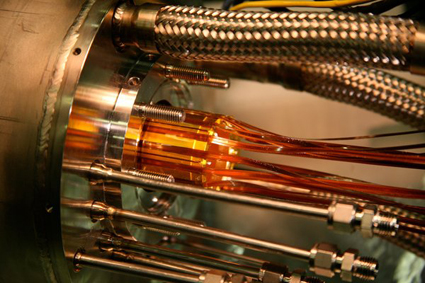Science News
Trapping Antimatter

One sixth of a second. For antimatter, a sixth of a second is almost long enough to get a glimpse of the birth of the universe, potentially solve physics mysteries and not (think Angels and Demons) blow up the world.
Publishing this week in the journal Nature, 40 scientists from around the world (and as nearby as UC Berkeley and Lawrence Berkeley National Laboratory), announced that they have now trapped 38 antihydrogen atoms, each for more than one-tenth of a second.
This is exciting news, because although the first artificially produced low energy antihydrogen atoms were created at CERN in 2002, until now these atoms have struck normal matter and annihilated in a flash of gamma-rays within microseconds of creation, keeping scientists in the dark about their properties.
From Universe Today:
Not only is this a science fiction dream come true, but in a very real way this could help us figure out what happened to all the antimatter that has vanished since the Big Bang, one of the biggest mysteries of the Universe.
The new experiments are happening at CERN, home to the Large Hadron Collider (LHC), under the name of ALPHA (Antihydrogen Laser PHysics Apparatus). In fact, ALPHA relies on the LHC. In order to make antihydrogen, the accelerators that feed protons to the LHC at CERN divert some of these to make antiprotons by slamming them into a metal target; the antiprotons that result are held in CERN's Antimatter Decelerator ring, which delivers bunches of antiprotons to ALPHA and another antimatter experiment.
ALPHA then takes the antiprotons and cools them and compresses them into a matchstick-size cloud (20 millimeters long and 1.4 millimeters in diameter). Then, the cloud of cold, compressed antiprotons is nudged to overlap a like-size positron cloud, where the two particles mate to form antihydrogen. All this happens inside a magnetic bottle, cooled to 9 Kelvin (or -443.47˚ Fahrenheit), that traps the antihydrogen atoms for that magical 172 milliseconds, or a sixth of a second.
The sixth of a second is just long enough to let the scientists know they have actually trapped it. The ALPHA team spokesman, Jeffrey Hangst, a Danish physicist, describes it this way in a great video on YouTube:
The way you know that you’ve done it, is you capture some antihydrogen and then release it intentionally. You let it go, at a given time and you look for an annihilation. That’s how we detect this has actually happened and that’s what this article in Nature is about.
(He also has a great description of antimatter in the video.)
What if physicists were able to hold on to these antihydrogen atoms a little longer? “We are getting close to the point at which we can do some classes of experiments on the properties of antihydrogen,” said Joel Fajans, UC Berkeley professor of physics and ALPHA team member. From 80beats in Discover:
If the scientists can extend that time… Fajans says, they can begin to play around with antimatter and figure out how its personality differs from ordinary matter’s, and why we live in a universe dominated by matter rather than its opposite.
Image: CERN